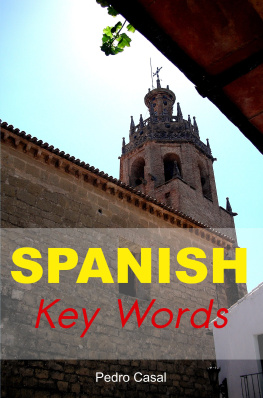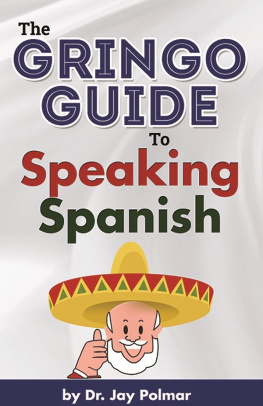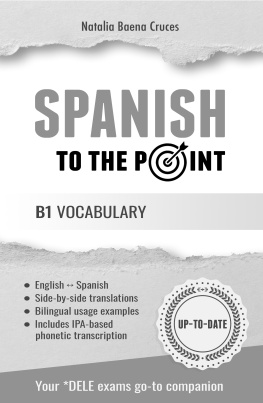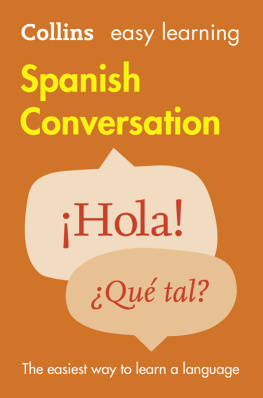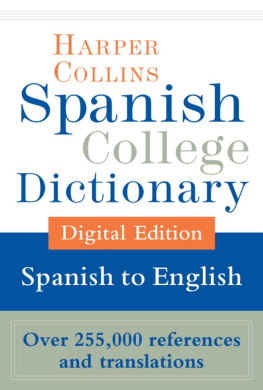SPANISH
KEY WORDS
the basic 2,000-word vocabulary
arranged by frequency in a
hundred units
with comprehensive Spanish and
English indexes PEDRO CASAL The Oleander Press The Oleander Press 16 Orchard Street Cambridge CB1 1JT www.oleanderpress.com © 1993 The Oleander Press Revised & Updated 2017 All Rights Reserved Cover Photograph by Enrique Dans This ebook has been optimised for viewing in landscape format.
CONTENTS
Introduction
Spanish Key Words has been designed as an efficient, logical, and practical computer-based word-list for anglophone learners of Spanish in their first year and second year. It has also proved valuable as a revision tool for more advanced students. The basic two thousand ‘key’ words are so called because by learning these one unlocks the door to many thousand more words: plurals from singulars, feminines from masculines, and parts of the present tense (where irregular) from the infinitive. Regular forms of the present tense are set out before Unit 1. One purpose of this technique is to stimulate confidence in the learning of Spanish by teaching the commonest words first, and leaving the less common till later.
Nothing is more daunting to the beginner than finding dozens of rare words which have to be looked up in a dictionary and may not recur in reading again for several years. Spanish Key Words is intended to be used with a conventional grammar and a conventional dictionary, but a massive dictionary has been found in practice to unnerve the beginner, while most available readers introduce too early words or ideas which may be arbitrary or advanced. At this sensitive phase, where interest in learning Spanish can be so easily encouraged or discouraged, it is suggested that the student should learn words in units of about twenty ‘key’ words each, thus mastering two thousand such words by the end of the first year. Only then will she or he be ready to accumulate arbitrary words of low occurrence, many of which will in any case be related to words already learnt. Computer-based methods are by now fully familiar in mathematics and the sciences, but statistical sampling has hitherto been rarely practised in language-learning, probably because of the difficulty of establishing a sufficiently large and accurate sample to make the frequency list reliable. The Oleander Press pioneered this approach in French Key Words (1984) by Xavier-Yves Escande and Italian Key Words (1992) by Gianpaolo Intronati.
The Units Each of the hundred units is self-contained, Unit 1 including the twenty commonest key words, Unit 2 the next commonest and so on. The key word is followed by an indication of its part of speech: adj., adjective; adv., adverb; conj., conjunction, f.n., feminine noun; interj., interjection; m.n., masculine noun; num., numeral; prep., preposition; pron., pronoun. Verbs are not so shown, because they are represented in each instance by their infinitive, which is always translated beginning with ‘to’. Masculine nouns and adjectives form their feminine by changing their final vowel from o to a, unless otherwise shown. So masculine amarillo becomes feminine amarilla. Singular nouns and adjectives form their plural by adding s if ending in a vowel, or es if ending in a consonant, unless otherwise shown.
So singular amarillo becomes plural amarillos and singular amarilla becomes amarillas. So singular lugar becomes plural lugares. Regular verbs ending in ar, -er and -ir are conjugated in model form in a separate table just before the hundred units. The commonest irregular verbs are conjugated (with pronouns and meanings in the early units) in the present tense of the active voice, indicative mood, wherever their infinitive occurs in order of frequency. Though verbs appear only in their infinitive form, their position in the units has been calculated from the total occurrence of all their parts. Many Spanish words may be translated by a number of English equivalents.
It would be counter-productive, in a work designed to stimulate interest rather than to clog the memory, to list all such equivalents, so only the most common have been cited, with the commonest of all first. When consulting the two indexes, therefore, the reader who cannot find a given word should try to think of synonyms or near-synonyms if a certain word seems to be omitted. The Indexes The two indexes permit the reader to use Spanish Key Words as a basic dictionary, but let it be repeated that the best available dictionary should be purchased to use in conjunction with the present aid, if it is intended to continue with Spanish past the elementary stage. The best possible grammar should be purchased too, reflecting either Castilian Spanish or Spanish-American usage, as appropriate. Spanish Key Words concentrates on standard Castilian usage. Another fascinating use of the indexes is to discover how frequent – and consequently how relatively useful – each Spanish word happens to be.
Of course the frequency level applies only to the Spanish words: nothing is implied at any point about the relative frequency of their English equivalents. Thus, patio appears in Unit 68 and convento in Unit 41, though neither appears in a list of the commonest 2,000 words in English. Even the most casual learner may be curious to discover that among the hundred most frequent words in Spanish only twelve are nouns. The first ten words are so common that they account for 36.55% of total occurrences in a lexical universe of over half a million words; the first hundred account for 66.2% of total occurrences; and the first thousand for 85.5%, figures remarkably similar to analyses of French and Italian by colleagues. It is therefore evident that anyone who masters the vocabulary in Spanish Key Words will only need another 10% or so to cover the entire corpus to be encountered on the internet and in newspapers, magazines, books and films.
Regular Verbs
in the Present Tense
| First Conjugation | Cantar, to sing |
| yo canto | I sing | nosotros cantamos | we sing |
| tú cantas | you (s.) sing | vosotros cantais | you (pl.) sing |
| él canta | he sings | ellos cantan | they sing |
| Second Conjugation | Temer, to fear |
| yo temo | I fear | nosotros tememos | we fear |
| tú tomes | you (s.) fear | vosotros teméis | you (pl.) fear |
| él teme | he fears | ellos temen | they fear |
| Third Conjugation | Partir, to leave, depart |
| yo parto | I leave | nosotros partimos | we leave |
| tú partes | you (s.) leave | vosotros partis | you (pl.) leave |
| él parte | he leaves | ellos parten | they leave |
N .B.
Conventionally, ‘él’, ‘he’ stands also for ‘ella’, ‘she’ in the conjugation of the present tense throughout this frequency list.
SPANISH
KEY WORDS
Unit 1
| de (prep.) | of |
| el (m., pl. los - art.) | the |
| la (f. pl. las - art.) | the |
| y (conj.) | and |
| a (prep.) | to, at |
| en (prep.) | in, into |
| él (pron.) | he |
| ser | to be, being |
| yo soy I am | nosotros somos we are |
| tú eres you (s.) are |

